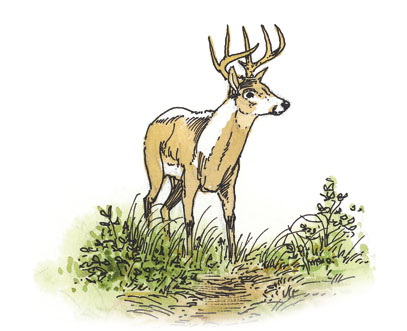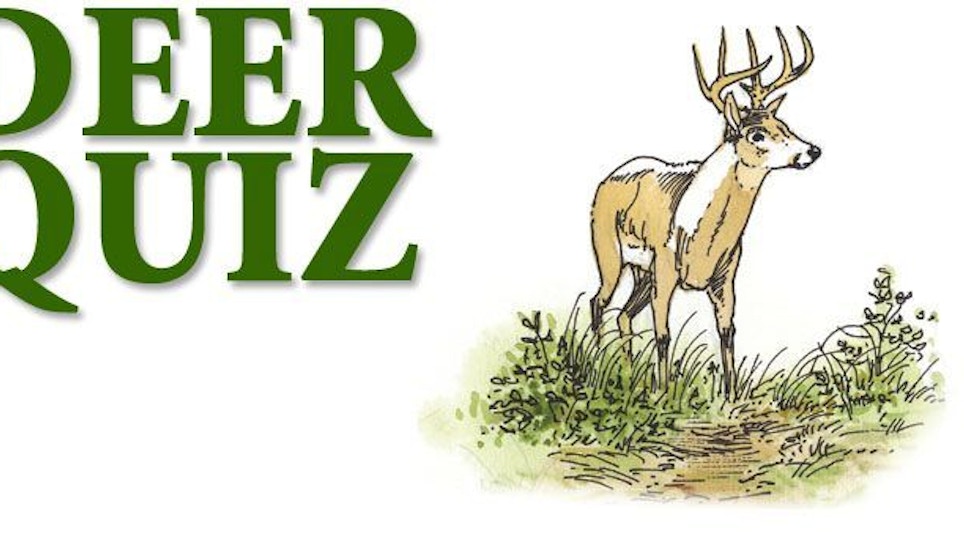 You might be the best shot in three counties, and can hang a tree stand in three minutes or less, but none of that will do you any good if you’re not savvy about whitetails. Take the following True or False quiz. If you answer all five correctly, make room for more trophies to hang on your den wall. Answer less than three correctly, and you might want to think about taking up fishing.
You might be the best shot in three counties, and can hang a tree stand in three minutes or less, but none of that will do you any good if you’re not savvy about whitetails. Take the following True or False quiz. If you answer all five correctly, make room for more trophies to hang on your den wall. Answer less than three correctly, and you might want to think about taking up fishing.
1. Bucks Will Be Bucks
Much as they might like to, mature bucks don’t hem up all the does in their neck of the woods and keep young pretenders at bay until the does are bred. The vagaries of the rut cycle, and the daily travels of does, make them accessible to bucks of any age. True or False?
2. The Hunter’s Moon
Deer and other animals are affected by lunar cycles in ways that scientists don’t completely understand, but that’s not to say that everything whitetails do is based on moon phases. Though many hunters believe that the rut is trigged by a full moon in fall or winter (depending on the latitude), the shortening of days (or changing photoperiod) is the major contributing factor. True or False?
3. I Now Pronounce You…
For a whitetail buck, rut success is often a matter of being in the right place at the right time when a receptive doe is available. Once the pair hooks up, the couple will remain monogamous until the doe is impregnated and is no longer willing to accept his advances. Then the buck takes off in search of another girlfriend. True or False?
4. Window of Opportunity
In general, the whitetail rut lasts for about 10 days. Latitude and longitude are the determining factors as far as when the rut begins in a particular locale, but the duration is fairly consistent. True or False?
5. Looking for Love
Bucks are homebodies when the rut is on, spending most of their time in a core area of about 10 acres that they have staked out with scrapes and rub lines. Though a “hot” doe passing through might lead a buck out of his home territory for awhile, he won’t stay gone for long. True or False?
CHECK OUT PAGE 2 FOR THE ANSWERS!!!
Answers:
1. True.  Dominant bucks can control access to does during the early stages of the rut, but all bets are off as the rut progresses and more willing does are present in a herd. A study report presented at the 30th annual meeting of the Southeastern Deer Study last year in Maryland indicated that, during the peak of the rut, mature bucks (at least 3 ½ years old) breed 55 percent of does. In the same time span, yearling bucks of 1 ½ years old breed 14 percent of the does while 2 ½-year-old bucks breed 21 percent of the does. The remaining 10 percent of does involved in the study either were not bred or the sires could not be determined.
Dominant bucks can control access to does during the early stages of the rut, but all bets are off as the rut progresses and more willing does are present in a herd. A study report presented at the 30th annual meeting of the Southeastern Deer Study last year in Maryland indicated that, during the peak of the rut, mature bucks (at least 3 ½ years old) breed 55 percent of does. In the same time span, yearling bucks of 1 ½ years old breed 14 percent of the does while 2 ½-year-old bucks breed 21 percent of the does. The remaining 10 percent of does involved in the study either were not bred or the sires could not be determined.
2. True. The commonly held notion that the lunar phase triggers the rut is not supported by science. In the North, many hunters believe
that the rut peaks about a week after the second full moon of the autumnal equinox (Sept. 21), which puts it around the first of November. However, studies conducted in various Northern states have concluded that the rut’s timing is coincidental to the lunar phase and not affected by it. A study of deer breeding cycles by graduate students at the University of Georgia supported that conclusion.
In the South, rut periods are all over the map, beginning in early October in some areas, or early February in other parts. The availability of does is a contributing factor, moreso in areas where there are many more does than bucks. A doe is receptive to a buck for a period of about 24 hours. If she is not bred then, she will experience estrus again in about 28 days. A doe that is not bred might come into heat a number of times before a buck breeds her. Bucks are capable of breeding soon after their antlers harden in early fall.
3. False. Researchers who studied whitetail populations in Texas, Mississippi and Oklahoma found that multiple matings between one doe and more than one buck is a fairly common occurrence. About 25 percent of the does involved in the study were observed breeding with different bucks on different occasions. Scientists deduced that at least some does might seek multiple matings to increase the likelihood of fawn fitness and survival, as adult does commonly give birth to twin offspring.
4. False. Though the shortening of days is the major triggering mechanism for the onset of the rut, the timing is at least partially a function of the gestation period (about 200 days) and prospects for fawn survival. In northern areas, the peak of the rut occurs in a narrower window of time so fawns born the following summer have a better chance of surviving their first winter, when forage is in short supply. In southern climes, where the habitat provides abundant food even during the heart of winter, fawn survival is not a major issue. Consequently, the rut period when does are receptive to bucks extends over a longer period of time. Studies of whitetails in the South have found that, in general, no more than 30 percent of available does are bred during any one week of a long rut cycle that might extend for weeks.
5. False. A Virginia telemetry study of deer movements on a 1,000-acre hunting club found that, during the rut, mature bucks traveled up to 2 ½ miles per day in search of willing does. Younger bucks fitted with radio collars tended to travel in straighter lines, suggesting that they were being hurried on their way by bigger, turf-protective bucks. Mature bucks tended to move in more circular patterns. One conclusion of the study is that quality deer management goals that include selective harvest of mature bucks won’t achieve optimum results on one hunting club unless other hunters in the area practice the same harvest regimen.






